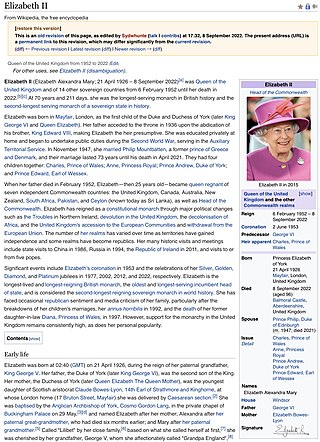Top Qs
Timeline
Chat
Perspective
Wikipedia coverage of death
From Wikipedia, the free encyclopedia
Remove ads
The volunteer editors of the online encyclopedia Wikipedia tend to update Wikipedia articles with information about deaths quickly after people die.[3][4] Web developer and Wikipedia editor Hay Kranen coined the term "deaditor" to refer to these editors.[5] Articles about people often have large spikes in views just after they die. For example, the article about designer Kate Spade averaged 2,117 views in 48-hour periods before her death. In the 48 hours after her death, it got 3,417,416, an increase of 161,427%.[6][7]

Media have remarked on the site's quick updates after the deaths of people such as Michael Jackson,[8] Elizabeth II,[5][9][10] and Henry Kissinger.[11][12]
In January 2009, in response to false death reports on the English Wikipedia articles about Robert Byrd and Edward Kennedy, the site's co-founder Jimmy Wales proposed that pages be moderated using Flagged Revisions, a form of protection under which certain revisions of a protected page must be accepted by an experienced editor before becoming visible to readers.[13] The feature, known as "pending changes" on English Wikipedia, was first implemented in 2010, though by 2021 it was not widely used on biographies of living people and was unmaintained.[14][15]
When a subject of a biography dies of a disease, its progress may also be described.[16][17]
Remove ads
References
Wikiwand - on
Seamless Wikipedia browsing. On steroids.
Remove ads
